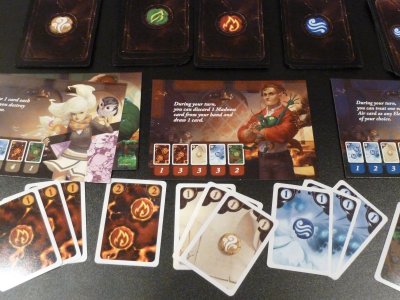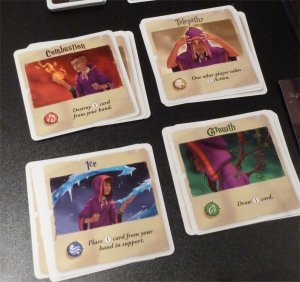

![[IMAGE]](../bilder/bibomad1.jpg) |
Designer: Publisher: No. of Players: Awards: |
![[IMAGE]](../technik/box/rot/rot-5.gif) ![[IMAGE]](../technik/box/gelb/gelb-10.gif) ![[IMAGE]](../technik/box/grun/grun-10.gif) ![[IMAGE]](../technik/box/pink/pink-9.gif) ![[IMAGE]](../technik/box/blau/blau-9.gif) |
|
A group of aspiring magicians rummaging through the basement of their college, opening a dark tome named "The Big Book of Madness" and by doing so triggering a flood a monsters which must be defeated in order to save the world? No, I am not talking about Harry Potter and his friends, and the college does not even bear the name Hogwards, but nonetheless designer Maxine Rambourg must have been inspired by J.K. Rowling's heroes when she started designing her game The Big Book of Madness. Released by IELLO and lavishly illustrated by Naiade, today's most wanted artist, the game takes the players onto a cooperative adventure to defeat the monsters escaping the ancient tome, and to accomplish this task the player characters have to master the arcane elements water, fire, earth and air
The Big Book of Madness runs on a simple but effective deck building mechanism, with each player managing his own character's deck. Since every character belongs to a different arcane field of study, the starting decks of each character slightly differ concerning the frequency of cards of each of the four elements. At the beginning of the game the player decks are mainly made up of value "1" Element cards, but during the course of the game the players also may spend cards from their deck to purchase Element cards with values "2" and "3", effectively increasing the power of their hand which is always restricted to a maximum of 6 cards. However, in the curse of the game the player decks will get polluted by Madness cards, generic cards without any function which must be added to the discard pile whenever a player's drawing pile is exhausted. These cards clog up the efficiency of the player decks and, even worse, a player who is unlucky enough to draw a full hand of 6 Madness cards will be considered to be gone insane and is out of the game.
 The Element cards on the players' hands will be used to power spells. At the beginning of the game each player is assigned an identical set of four beginner spells, and these spells offer some basic functions like drawing an additional card, destroying a hand card (possibly a Madness card) or allowing another player to perform an action out of turn. However, there also exists an open display of 4 spell decks belonging to the 4 elementary schools, and the players also can use Element cards from their hands to purchase new, more powerful spells from these decks, replacing some of their older spells when they have reached a total of 5 available spells. As indicated, the spells which can be bought during the game are far more powerful, allowing combinations of the basic actions and positive effects for other player characters. In addition, the spells usually have a variable efficiency, allowing a player to overpay the Elements needed to cast a spell by two or even three times. If such an overpayment is made, the spell's effect is doubled or tripled, and this allows the players to make some quite interesting decisions when enhancing their character decks with new Element cards.  But what about the ole Big Book and the freaky monsters? Well, during setup the Big Book has been prepared as a stack by randomly assigning a cover card, five inner pages and a backside card, and during the first round of play the cover will be lifted and placed left of the rest of the book, thus revealing a new monster on the backside of the cover and some effects associated with winning or loosing combat against this monster. In effect, the Big Book is constructed similar to the books found in Valdora, since during the course of the game the pages of the book will be flipped one by one, and the contents of each double page will be similar to the first double page, always showing a monster and the rewards/detriments for winning or loosing against this monster. Due to the double pages, the game is far less repetitive, since each game will see the players facing different combinations of monsters and effects. Each of the monsters will bring along a number of Curse cards which is depicted on the Monster card, and these Curses will be placed on a five-stepped circular track found on the main gameboard. During each player's turn an Invocation marker will be moved one step forwards on this track, and whenever the Invocation marker reaches a new Curse card the card will be triggered, resulting in some negative effects for the players (loosing hand cards etc.). The players on the other hand try to destroy the curses by discarding a combination of Element cards listed on the individual Curse card, and the removal of the curses is not only necessary to avoid their negative effects, but also to defeat the current monster, since each monster only stays for a total of 5 player turns. After 5 turns the round is over, and if the players have not succeeded in removing all Curse cards brought by the monster the negative effect shown of the right page of the Big Book will be triggered. If, on the other hand, all Curses were removed, the monster was banished and the players will receive a benefit. Regardless of the fact whether the players or the monster were able to win the round, the next page in the Big Book now will be turned over, revealing a new monster and its curses. The game continues in this fashion until the sixth and final monster arrives. At this point there will be no backing down, since the sixth monster is the Overlord which the players must overcome at all cost since the defeat of the Overlord decides whether the players win or lose the game. Now it will show whether the players have played effectively, acquiring stronger spells and increasing the efficiency of their individual decks, or if they have tarried, being defeated by the previous monsters and collecting destructive Madness cards.  Apart from the interesting powering up of the Spell cards which gives the players a slightly advanced deckbuilding challenge, The Big Book of Madness also features a nice mechanism which results in increased player interaction. There exists a choice of spells in the game which allows the players to place up to three of their hand cards into a common Support Pool. Apart from the fact that cards placed in support will remain there until they are used (not counting against a player's hand limit), the Support Pool is open to all players, allowing them to draw on the cards placed their by their fellow magicians. This opens up a number of options unknown to competitive deckbuilding games like Thunderstone or Dominion, since the players now actually have the possibility to combine their forces to remove an especially nasty curse, or to heal Madness cards placed into support by another player. This also must be seen in combination with the spells available to each player, since the Support Pool allows for a higher degree of specialization, allowing some players to play more aggressively whereas others might build up efficient healing capacities. It is exactly this high level of player interaction which gives The Big Book of Madness a special charm, since the players effectively are given an additional strategic level which they can discuss. Due to this the cooperative approach as presented in the game feels more "complete" than in other, quite individualistic wannabe cooperative games. In such games it usually will be appreciated if the alpha-player takes a breather, but in The Big Book of Madness monster effects which force the players to remain silent really will feel like punishment. So, let's give a warm welcome for Maxine Rambourg for a great debut game! | ||
|
| ||

|
|

|
|
| ||
|
Impressum / Contact Info / Disclaimer Kulkmann@aol.com
Copyright & copy; 2015 Frank Schulte-Kulkmann, Essen, Germany | ||